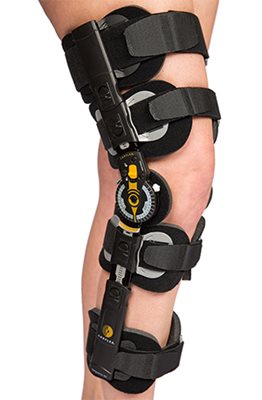 The aim of knee bracing treatment is to control the knee, minimising the risk of further injury which could ultimately result in knee replacement surgery.
The aim of knee bracing treatment is to control the knee, minimising the risk of further injury which could ultimately result in knee replacement surgery.
Knee braces can help to reduce the impact of arthritic damage, reduce pain and improve mobility. It can also help to support a ligament deficient knee joint during activities such as skiing, wakeboarding and football. Not all types of knee injury require the same type of bracing solution.
Common knee injuries:
Osteoarthritis
This occurs when one or more compartments of the knee joint becomes worn out due to excessive wear and tear or uneven load. This can be very painful for the individual as it limits movement and mobility. There are a variety of knee braces designed to off-load the affected area of the knee reducing pain and delaying the need for joint replacement surgery.
Ligament tear
There are four main ligaments in the knee which help to stabilise the joint. If a ligament becomes strained or torn the stability within the joint can become compromised, making the knee give way and feel unstable. Ligament bracing helps to stabilise the joint by functionally replacing the damaged ligament. Knee bracing can also be used prophylactically to minimise the risk of damage to ligaments during extreme sports, for example customised braces that can be accommodated within specific sports equipment such as ski boots.
Meniscal tear
This can occur in one or more areas of the knee joint, reducing the range of movement and creating instability in the joint which results in a lot of pain. Whilst bracing will not repair the tear entirely, it can replace the lost stability in the joint.
Anterior knee pain or patella femoral joint pain
This is often associated with pain behind the knee cap, and can be aggravated by climbing stairs, sit to stand movements and squatting. This can be caused by over use of the joint, over pronated feet, hypermobility, mal tracking of the patella or muscle weakness in the thigh muscles. Bracing can alter the tracing around the patella, reducing the damaging forces and reduce the pain; insoles can also be used to improve foot and ankle biomechanics reducing strain at the knee.
Through assessment and prescribing the correct knee brace, our expert orthotists will help you to return as close to original performance as possible to lengthen your active life and minimise unnecessary wear and tear. For more information on wearing and caring for a knee brace, click here for our patient information guide.
Contact us today for a consultation on the most suitable knee brace solution for your needs.